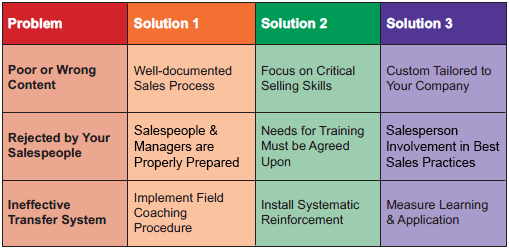
A WORD FROM DUANE SPARKS
Dear Sales Executive:
How often have you wondered whether the sales training you buy is actually worth its cost? For my money, sales training can be considered successful only if it produces meaningful, long-lasting gains in sales performance.
If that is the standard for success, then here’s some bad news: 90 percent of all sales training fails. That means 90 percent of the $1 billion spent on sales training every year is essentially wasted.
This is the third in a series of eCoach newsletters in which I explain why so much sales training fails, and how to make it succeed instead. Please read on.
If you have a question about how to make sales training pay off with spectacular results, click on “Ask The eCoach“.
We are committed to your professional success.
Duane Sparks
Author of Action Selling ®
Learning It Is One Thing, Doing It Another
I am frankly embarrassed to work in an industry whose products have a 90 percent failure rate. Yes, that is the approximate percentage of sales training programs that fail to produce meaningful, long-term gains in sales performance in the field.
Sales performance “in the field” is, of course, the only place where performance really matters. That brings us to the subject at hand. I believe that there are three major reasons why so many sales training programs fail. A newly revised white paper available on our web site explains them in depth (see link at bottom).
Here is a quick graphic view:
 In previous editions of this newsletter, I explored the first two of those reasons:
In previous editions of this newsletter, I explored the first two of those reasons:
- Programs have the wrong content. They simply try to teach the wrong things.
- The training is rejected by salespeople. Trainees never really buy into the premise that the program has useful things to teach.
Now let’s look at the third major cause of failure: ineffective transfer of new skills from the learning environment to the field – the place where better performance would really matter.
“Transfer” is a term we use for learning that actually gets applied in the field. It’s the only reason why a business organization, as opposed to a school or college, would want to invest in training in the first place. No transfer? Then no performance gains. No performance gains? Then no success.
Most people mistakenly think of transfer as a synonym for follow-up or reinforcement – things that happen after the training program is over. Yes, those things are necessary, and they do contribute to successful transfer. But other factors play into the transfer process as well.
Follow-up and reinforcement are necessary, but they aren’t the whole ball game.
Here are the critical elements that determine whether learning will transfer from the classroom (or learning environment) to the job.
- Students must be actively involved in the entire learning process.
- Early in the training process, students need to connect the learning to their life experiences. It has to make sense in the world they know. They need to see relevance right away.
- They must know that there will be follow-up activities and assessments that measure what they learned and also measure how well they are applying the new skills in their day-to-day work.
- They must be held accountable by their managers to demonstrate the use of new skills and knowledge in the field. This cements the message that management believes the learning was important.
- The employer must take a systematic approach to reinforcement. Acting as coaches in the field, managers must minimize the “transfer distance” by helping learners apply new skills and knowledge on the job—quickly. Assign online “skill drills” as homework. In everyday conversations about job performance, use the specific language that was taught in the training. Force the learned concepts into routine use.
Want to invest in sales training that actually succeeds? Start with three fundamental rules:
- Teach the right skills, and teach them the right way.
- Anticipate possible rejection, and make sure salespeople believe that the training program will benefit them personally.
- Treat “transfer” as a crucial goal that requires plenty of attention and a systematic approach.
Follow those rules, and your odds of success will increase astronomically.
For information about how to make sales training pay huge dividends, contact Action Selling ® at (800) 232-3485.
For a fuller discussion of the key factors that determine whether sales training will succeed or fail, see our newly revised white paper, 90% of All Sales Force Training Fails: Here’s the Problem – And the Solution.
Recent eCoaches
Don’t Look Now, But Your Sales Culture Gap is Growing
Close Your Culture Gap! Align Sales and Service
Why 64% of Salespeople Don’t Close
Stalls Vs. Objections: No, They Don’t Have the Same Solution
No Detours! Why Must You Leave the Sales Path Just to Handle an Objection?
I Object! (To the Way You Define Objections)
How to Train Your Way Out of a Sales Slump
It’s Not What You Sell, It’s How You Sell
How Do You Know If Your Sales Force Is Good?
“One Call” Close Not Dead Yet?
TQM for Sales Leadership? Yes!
Six Critical Processes for Sales Leaders
10 Great Ideas About Sales Leadership
The Three Core Roles of Every Sales Leader
The Nine Acts of Sales Leadership
5 Secrets to Record-Breaking Sales
Sales Training That Actually Works
The Sales Leader’s Toughest Challenge
How Strong is Your Sales Culture?
Want to Create the Best Sales Culture?


ASSESS YOUR SALES SKILLS
Unlock your hidden sales potential today – take our free Selling Skills Assessment.

THE NEW ACTION SELLING
A Quick Read That Will Boost Your Sales — Guaranteed!


